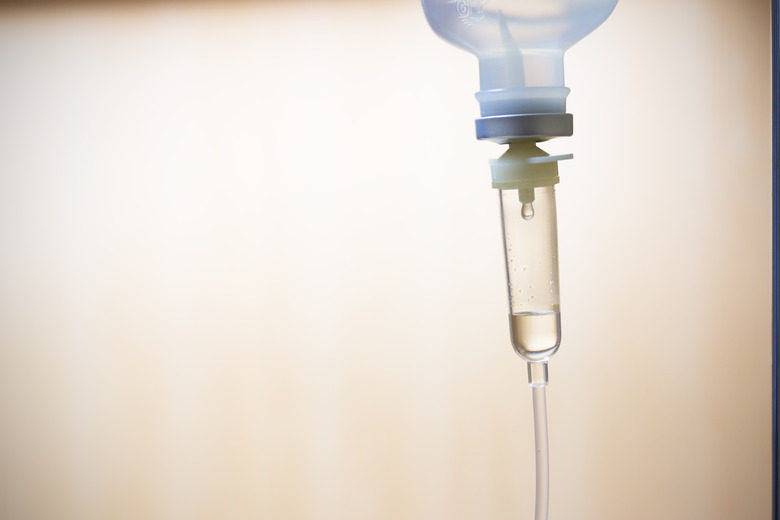How To Make A Sodium Chloride Solution
A solution of sodium chloride — better known as table salt — and water is known as a saline solution; there are many reasons why you would need one. For example, a normal saline solution, which is one that matches the salinity of the body, is the best one for making a dental rinse or flushing out the eyes. You can mix a percentage-by-weight saline solution by weighing the salt you add to a specific amount of water, or you can mix a molar solution — useful for lab work — by calculating the molecular weight of a sodium chloride molecule.
Mixing a Percentage-By-Weight Solution
Step 1
Pour clean water into a graduated flask large enough to hold the amount of solution you need. To get a pure saline solution that is free of impurities, you should use distilled water. Fill the flask with about 80% of the water that will be in the final solution. For example, if you're making 100 milliliters of solution, fill the flask to the 80-milliliter mark.
Step 2
Calculate the weight of salt you need. The weight — measured in units compatible with the water volume units — determines the percentage of the solution. Divide it by the volume of water and multiply by 100 to get the percentage. For example, to make 100 milliliters of normal saline solution, which is a 0.9% solution, you need nine grams of salt. If you need a pint of solution, you should add 2.9 tablespoons of salt.
Step 3
Measure the salt and add it to the water. Swirl the flask until all the salt is dissolved. Once all the salt is dissolved, add water to increase the volume to the originally-intended amount.
Mixing a Molar Solution
Step 1
Mix a molar solution in one liter of water. Molar concentrations are expressed as the number of gram-molecular masses of solute — in this case sodium chloride — you add to this liter of water.
Step 2
Look up the molecular weights of sodium and chlorine on a periodic table. A salt molecule has one of each element, so you can add their weights together to get 58.44, the molecular weight of sodium chloride.
Step 3
Fill a flask with 0.8 liters of water, weigh out the amount of sodium chloride you need, add it to the water and shake until it dissolves. To make a 1M solution, add 58.44 grams of salt; to make a 0.1M solution, add 5.84 grams; to make a 2M solution, add 116.88 grams and so on.
Step 4
Add water to the flask to bring the final level to one liter after all the salt has dissolved.
Things Needed
- Graduated flask
- Distilled water
- Scale
- Table salt
TL;DR (Too Long; Didn't Read)
If you're making a normal saline solution to use as a mouthwash, you should boil the water before adding the salt. Use non-iodized table salt. Using rock salt or sea salt will introduce contaminants.
Warning
A homemade saline solution is not as pure as one made in a laboratory with antiseptic conditions. Don't use a homemade solution to soak contact lenses or to flush your eyes.
Cite This Article
MLA
Deziel, Chris. "How To Make A Sodium Chloride Solution" sciencing.com, https://www.sciencing.com/make-sodium-chloride-solution-4514459/. 30 April 2018.
APA
Deziel, Chris. (2018, April 30). How To Make A Sodium Chloride Solution. sciencing.com. Retrieved from https://www.sciencing.com/make-sodium-chloride-solution-4514459/
Chicago
Deziel, Chris. How To Make A Sodium Chloride Solution last modified March 24, 2022. https://www.sciencing.com/make-sodium-chloride-solution-4514459/
